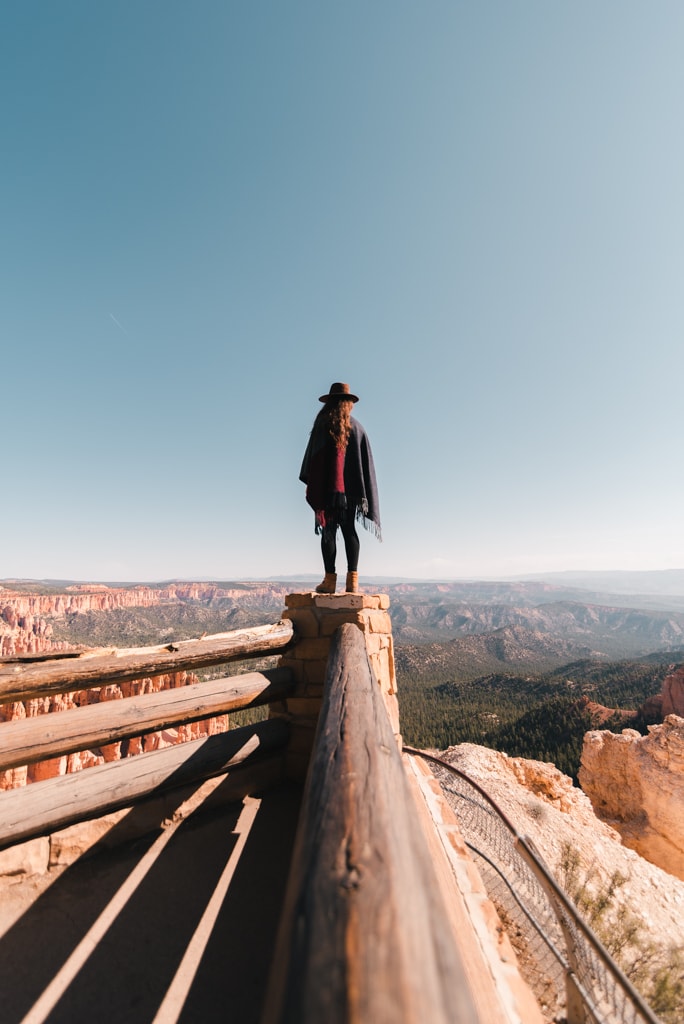Zion National Park
Of the many incredible states, Utah holds some of the most adventurous National Parks including one of the most popular — Zion National Park. If you have a fear of heights or water, we recommend you opt for a easy hike or come prepared to conquer your fears. A few daring hiking trails come to mind when we think of Zion — Angel’s Landing with its steep cliffs & tight pathway and the Narrows with its winding canyon walls soaring above the Virgin River. People flock to this national park every year to crush these taxing hikes. A majority of the year a mandatory shuttle bus runs from a parking lot immediately inside the park as well as from Springdale, UT (the nearest town). We suggest going as early as possible so you can catch an early shuttle and make the most of your day before it gets too crowded.
Everything you need to know about the shuttle is updated on the NPS website: https://www.nps.gov/zion/planyourvisit/shuttle-system.htm.
Bryce Canyon National Park
Hoodoos? What are those? Welcome to Bryce Canyon National Park where you’ll find out more about these unique rock formations. This park is easily one of the most accessible when it comes to the views. A quick drive through Bryce Canyon and you’ll be able to stop at every single viewpoint this park has to offer. If you’d like to, you can take some hiking trails to get further in to truly experience the hoodoos yourself. Otherwise, all the sights are pretty much available to you from the main road. We recommend starting at the end of the park (Rainbow Point) and working your way back towards the beginning (Sunrise Point). This will allow you to see a few viewpoints with a little less of a crowd which will make it even more enjoyable. Most of the hikes in this area lead to these viewpoints so even if you’re limited on time, you’re still able to see all the best views of this National Park!
Capitol Reef National Park
You can easily do a few day hikes at Capitol Reef National Park in one day but our favorite thing to do in the area is go off-roading in Cathedral Valley via Cathedral Valley Rd. We can’t recommend this area enough! If you have a 4×4 or 4wd, you have to see Cathedral Valley and all it has to offer. You can do the full loop from Hartnet Road to Cathedral Valley Rd. or vice versa or even just do part of it and head back the same way you came. We like to head as far as Temple of the Sun and Temple of the Moon but there are many other sights to see along this route. One thing to keep in mind is that if you take Hartnet Road be prepared to do a river crossing in your vehicle and turn back if you feel like the water is too high as this area is prone to flash floods. If that’s the case, you can take Cathedral Valley Road instead and you’ll get the same views without the high risk. You’ll still need a 4WD vehicle as the road is still pretty rough. Be prepared on gas and water as with most off-roading areas, the closest gas station and cell service are outside the park and a few miles away.
Arches National Park
Have you ever seen a Utah license plate? Remember that arch you always see? Well, that icon is real! Arches National Park includes many arches but Delicate Arch is the one that everyone comes to see after all it’s the same one that’s displayed on Utah license plates. Although, Delicate Arch isn’t the only one worth seeing. Arches offers a few pretty easy day hikes to some of the coolest arches you’ll ever see. Our favorite place to catch sunset is the “Windows” section where you’re surrounded by several different arches. Each hike is more like a short walk which makes it easily accessible to the mass majority.
Canyonlands National Park
The least visited of all of Utah’s National Parks due to the accessibility but definitely not one to miss. This park consists of mostly off-roading paths that require 4WD/4×4 vehicles and a permit from the Visitor Center. If you happen to have both of those then you’ll be in for windy roads, canyons, and some more crazy rock formations that a majority of others will never get to see. For those less fortunate, you can still see parts of the park by going to turn outs or parking in the lots they do have and walking along the trails. One notable sight is Mesa Arch where photographers line up along the side to capture the beauty of sunrise through the golden archway.
Tips
National Park Pass
We recommend buying an annual National Park pass if you’re planning to visit all of Utah’s National Parks. Even if you won’t be using the park pass after this, it’ll be worth it after the third park you use it on. The pass costs $80 and lasts you ALL YEAR LONG. If you visit ONE park without it, you’ll have to pay $35. You might as well just get the America the Beautiful Pass because this will give you easy access to all of the National Parks in the nation.
You can buy this at any federal recreation site or online https://store.usgs.gov/pass
Best Times to Go
We’ve been in the dead of winter where we were hit with snowstorms and we’ve also been in the hottest of summer where we sweat our butts off. We’d recommend either late spring or early fall. During these times, there are slightly less visitors, still decent weather, and almost all of the trails/roads are open. Summer was way too hot for us since we were tent camping and car camping a majority of it. Winter brought closed roads and snowstorms that made us worry if we were going to make it back home. Every season has their pros and cons but we’d like to think April through October are some of the best times to visit. Be prepared for large crowds as always since even though these are smaller parks compared to some others, they are still some of the most popular.

